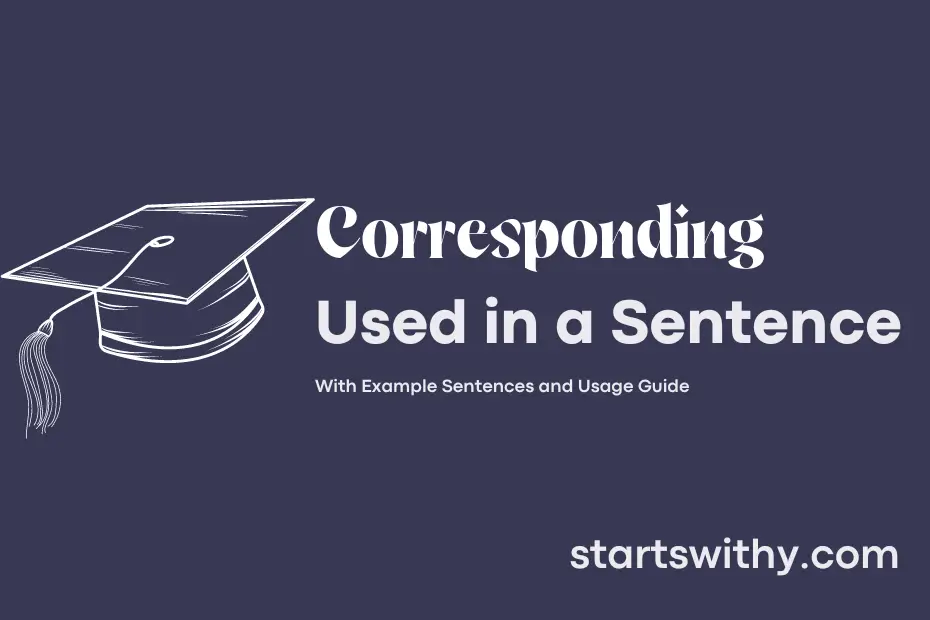Have you ever wondered how to properly link two related pieces of information in a sentence? This is where the term “corresponding” comes into play. In the English language, when we talk about the corresponding item or detail in relation to another, we are highlighting a direct connection or matching relationship between the two.
In grammar and writing, using “corresponding” helps to establish clarity and coherence by indicating the specific association or correlation between elements. It serves as a bridge to show that one component directly corresponds to or aligns with another in a sentence, paragraph, or text.
7 Examples Of Corresponding Used In a Sentence For Kids
- The red block has a corresponding blue block.
- Match the animals with their corresponding habitats.
- Find the corresponding shapes in the picture.
- Draw a line to connect the numbers with their corresponding words.
- Can you point to the corresponding picture on the worksheet?
- Color the fruits with their corresponding colors.
- Look for the corresponding pairs of socks in the laundry basket.
14 Sentences with Corresponding Examples
- Make sure to submit your assignment on time along with the corresponding plagiarism report.
- Please remember to pay the corresponding fees for your exam registration before the deadline.
- The professor will provide feedback on your project proposal and suggest the corresponding improvements.
- Ensure you attend the corresponding lecture for this topic to better understand the concept.
- Make sure to reference the corresponding textbooks in your research paper for accurate information.
- The library has a section dedicated to each department with the corresponding books and resources.
- Your grade will be updated on the portal along with the corresponding feedback from the instructor.
- Don’t forget to complete the corresponding pre-requisite courses before enrolling in advanced classes.
- The internship coordinator will assign you to a company with the corresponding field of your study.
- Attend the workshops and seminars to gain insights into your field and the corresponding networking opportunities.
- The syllabus provides details about the topics covered and the corresponding weightage of each unit.
- The lab assistant will guide you on conducting experiments and understanding the corresponding results.
- Make sure to follow the citation guidelines for incorporating corresponding references in your thesis.
- The timetable lists the schedule of classes, exams, and the corresponding faculty members for each subject.
How To Use Corresponding in Sentences?
To use the word Corresponding in a sentence, you first need to understand its meaning. Corresponding is an adjective that is used to describe something that is similar or related to something else.
Here is a simple guide on how to use Corresponding in a sentence:
-
Identify two things that are related or similar in some way. For example, “The size of the shoe corresponds to the size of the foot.”
-
Place the word Corresponding before the noun or adjective it is describing. For example, “She wore a small dress, and he wore the corresponding small shirt.”
-
Use Corresponding to show a connection between two elements in a sentence. For example, “The increase in temperature corresponded with a decrease in snowfall.”
-
Remember to keep the structure of the sentence clear and concise. For example, “The height of the tree was corresponding to the size of the building.”
By following these steps and practicing with different sentences, you will become more familiar with how to use Corresponding effectively in your writing.
Conclusion
In writing, using sentences with corresponding ideas is crucial for maintaining clarity and coherence in a piece of text. By ensuring that each sentence flows logically from the previous one, the writer can create a seamless and easy-to-follow narrative for the reader. This style of writing allows for the development of complex ideas in a structured manner, enhancing the overall readability and comprehension of the text.
When constructing sentences with corresponding themes or concepts, it is important to pay attention to transitions and connections between ideas. Whether using words like “similarly,” “conversely,” or “in addition,” these linking devices help establish a strong relationship between sentences, guiding the reader through the progression of thoughts. By mastering this technique, writers can effectively communicate their message and engage their audience more effectively.



